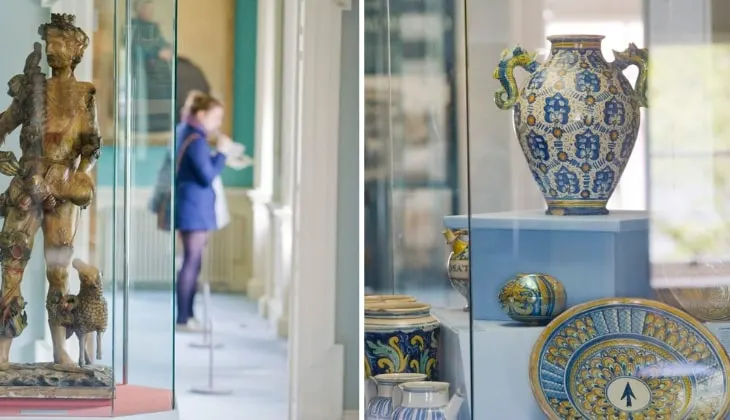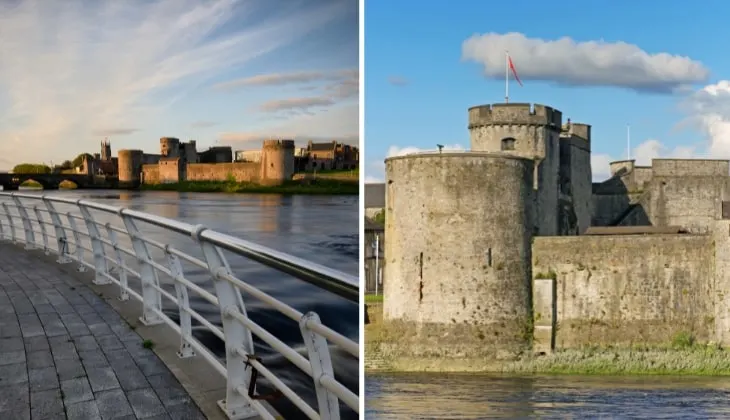St John’s Cathedral in Limerick truly is a sight to behold.
Boasting one of the tallest spires in Ireland, St John’s Cathedral dates back to 1856, when its foundation stone was laid.
In the guide below, you’ll discover what to lookout for both in and outside the cathedral. Dive on in!
Some quick need-to-knows about St John’s Cathedral

Photos via Shutterstock
Although a visit to St John’s Cathedral is fairly straightforward, there are a few need-to-knows that’ll make your visit that bit more enjoyable.
1. Location
Saint John’s Cathedral is located in the centre of Limerick at Cathedral Place. It’s a 5-minute walk from The Milk Market and a 10-minute walk from both the Hunt Museum and St Mary’s Cathedral.
2. Opening hours
Unfortunately, we couldn’t find the exact opening times of the cathedral online, however, mass is celebrated at 10 am and at 5.45 pm from Monday to Saturday except during bank holidays, when only the morning mass takes place.
3. Please be respectful
During your visit make sure to be respectful – this is a place of worship and should be treated as such. It’s important to keep in mind that this is first and foremost a religious site and not merely a tourist attraction.
4. One of the highest spires in Ireland
St John’s Cathedral was thought to have the highest spire in Ireland (95 metres/308 feet). However, recent measurements have verified that the actual length of the spire is 81 metres (266 feet). Nonetheless, the cathedral’s impressive spire still remains one of the highest in Ireland.
The history of Saint John’s Cathedral
The story of St John’s Cathedral all begins with the laying of its foundation stone by bishop John Ryan in 1856. History buffs will know that this was less than a decade after the Great Famine came to an end.
The design of the cathedral was placed in the capable hands of and English architect named Philip Charles Hardwich.
Style and construction
Hardwich opted to design the cathedral in a ‘Gothic revival style’ – this was an architectural movement that kicked off in England during the 1740s.
Word began in 1856 and, although the first mass was celebrated at St John’s Cathedral in 1859, the building remained unfinished until its completion in 1861.
The tower
It wasn’t until 1882 that a Limerick firm was commissioned to design the cathedral’s magnificent tower.
It’s said that the firm used the original sketches and adapted them so that the structure stood 32 metres (105 feet) higher.
Restoration work
The cathedral has been carefully maintained over the years. In fact, it has been restored every 25 years since its construction was completed.
The first of these restoration projects took place before the Cathedral consecration in 1894. A major work of restoration was again carried out in the 1950’s under the direction of Bishop Patrick O’Neill and in 1977 thanks to a fundraising campaign.
The last restoration works were carried out at the beginning of the 21st century under the direction of bishop Donald Murray.
Things to look out for at Saint John’s Cathedral

Photos via Shutterstock
There’s plenty to keep an eye out for when you visit St John’s Cathedral and it’s worth taking 30 seconds to scan the below so that you don’t miss anything.
1. The stunning exterior
Before heading inside, make sure to have a look at this impressive building from the outside. See the beauty of the facade and gaze up at the impressive tower bell. Have a walk around the little courtyard surrounding the church and get a 360-degree view of the building.
2. The Bishop’s Throne and Cathedral Chapter Stalls
The Bishop’s Throne and the Cathedral Chapter Stalls were crafted in Munich in 1984. You’ll find the magnificent Bishop’s Chair in the centre of the apse, set against the original reredos of the high altar.
3. The Altar
As you proceed towards the end of the nave, you will see the altar of St John’s Cathedral. The main table is made of Limerick marble while its substructure consists of alabaster and coloured marble. The centre is decorated with a representation of the sacrifice of Abraham entirely carved in pure white alabaster.
4. The Labyrinth
The Labyrinth refers to the area surrounding the main altar. This surface is laid out to represent the path of Christian life. The design of this particular labyrinth was based on Michelangelo’s, appearing as a twelve-point figure representing the 12 apostles who followed Jesus Christ in his life on Earth.
5. The organ
The massive wooden organ was a present from the 3rd Earl Dunraven of Adare. This imposing instrument dates back to 1864 and was built by the prestigious William Hill & Son. This organ has been overhauled a number of times since the 19th-century, like in 1917 when it was converted to pneumatic action by Norman Hill and Beard Hill.
6. The tower
The tower bell of St John’s Cathedral is the fourth tallest in Ireland. It was designed in 1878 and is 81 metres (266 feet) in height. It’s characterised by a base of 2.2 square metres (24 feet square) in area and walls of approximately 1 metre (4 feet) in width. The material used for the tower is mainly limestone quarried at Rosbrien.
Things to do near St John’s Cathedral
One of the beauties of the cathedral is that it’s a short spin away from many of the best things to do in Limerick.
Below, you’ll find a handful of things to see and do a stone’s throw from St John’s (plus places to eat and where to grab a post-adventure pint!).
1. The Milk Market (5-minute walk)

Photos via Country Choice on FB
So, there’s some incredible restaurants in Limerick (there’s som great old-school pubs in Limerick, too), yet we find ourselves returning to the city’s historic Milk Market over and over again.
2. Museums and galleries (10 to 15-minute walk)

Photos by Brian Morrison via Ireland’s Content Pool
If you’re visiting when it’s raining, Limerick boasts some great museums and galleries, like the Hunt Museum and Limerick City Gallery of Art (the museum at Thomond Park Stadium is another popular spot).
3. Saint Mary’s Cathedral (10-minute walk)

Photos via Shutterstock
St Mary’s Cathedral is situated in the centre of Limerick in Bridge Street. This church dates back to 1168 and is the oldest building in Limerick that’s still in use to this day.
4. King John’s Castle (12-minute walk)

Photos via Shutterstock
King John’s Castle is located on the bank of the River Shannon and it’s one of the most impressive castles in Ireland. Take the tour and immerse yourself in Limerick’s past.
FAQs about visiting St John’s Cathedral in Limerick City
We’ve had a lot of questions over the years asking about everything from ‘What’s there to see?’ to ‘When is it open?’.
In the section below, we’ve popped in the most FAQs that we’ve received. If you have a question that we haven’t tackled, ask away in the comments section below.
How tall is St Johns Cathedral Limerick?
The cathedral stands at an impressive 81 metres (266 feet) tall and can be seen from many parts of the city.
What is there to see at St John’s?
Keep an eye out for the tower, the organ, the Labyrinth, the Altar, the Bishop’s Throne and Cathedral Chapter Stalls and the stunning exterior.
